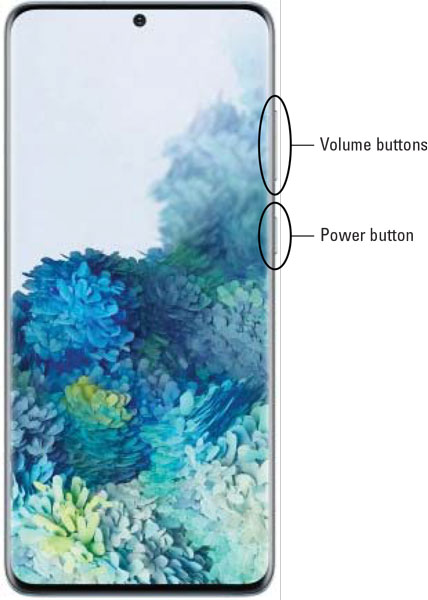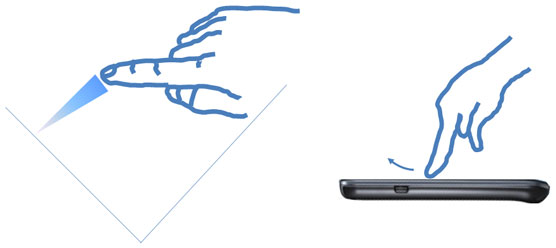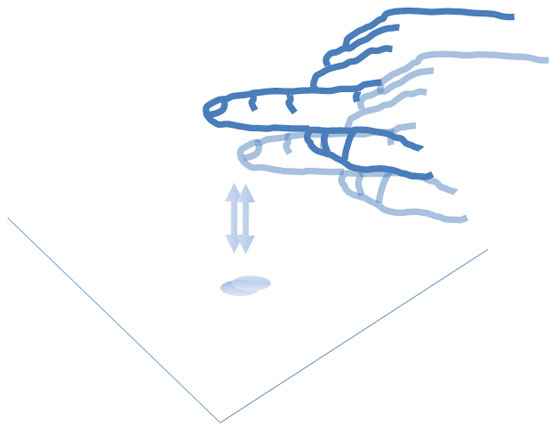The phone’s hardware buttons
Samsung has reduced the number of hardware buttons on the Galaxy S20. There are only three: the Power button, the Volume Down button, and the Volume Up button. Before you get too far into using your phone, orient yourself to be sure that you’re looking at the correct side of the phone. When I refer to the left or right of the phone, I’m assuming a vertical orientation (meaning you’re not holding the phone sideways) and that you’re looking at the phone’s screen.The Power button
The Power button is on right side of the phone, toward the middle when you hold it in vertical orientation.In addition to powering up the phone, pressing the Power button puts the device into sleep mode if you press it for a moment while the phone is On. Sleep mode shuts off the screen and suspends most running applications.
The phone automatically goes into sleep mode after about 30 seconds of inactivity to save power, but you might want to do this manually when you put away your phone. The Super AMOLED (Active-Matrix Organic Light-Emitting Diode) screen on your Samsung Galaxy S20 is cool, but it also uses a lot of power.
Don’t confuse sleep mode with powering off. Because the screen is the biggest user of power on your phone, having the screen go blank saves battery life. The phone is still alert to any incoming calls; when someone calls, the screen automatically lights up.
The Volume button(s)
Technically, there are two Volume buttons: one to increase the volume, and the other to lower it. Their locations are shown. The Galaxy S20 Volume buttons on the upper right.
The Galaxy S20 Volume buttons on the upper right.The Volume buttons control the volume of all the audio sources on the phone, including:
- The phone ringer for when a call comes in (ringtone).
- The notifications that occur only when you’re not talking on the phone, such as the optional ping that lets you know you’ve received a text or email.
- The phone headset when you’re talking on the phone.
- The volume from the digital music and video player (media).
The Volume buttons are complementary to software settings you can make within the applications. For example, you can open the music-player software and turn up the volume on the appropriate screen. Then you can use the hardware buttons to turn down the volume, and you’ll see the volume setting on the screen go down.
Another option is to go to a settings screen and set the volume levels for each scenario. Here’s how to do that:
- From the Home screen, press either Volume button. You can press it either up or down. Doing so brings up the screen shown.
 The ringer volume pop-up.
The ringer volume pop-up.If you press the Volume Up or Volume Down button, the ring tone gets louder or softer. Hold off on this tweak for now and go to the next step.
- From this screen, tap the arrow down in the upper-right corner. Tapping it brings up the screen shown in the following figure.
- From the screen shown, set the volume at the desired setting.
 The All Volume Settings pop-up.
The All Volume Settings pop-up.You can adjust the volume of any setting by placing your finger on the dot on the slider image. The dot will get bigger; you can slide it to the left to lower this particular volume setting or to the right to raise it.
The touchscreen
To cram all the information that you need onto one screen, Samsung takes the modern approach to screen layout. You’ll want to become familiar with several finger-navigation motions used to work with your screen.Before diving in, though, here’s a small list of terms you need to know:
- Icon: An icon is a little image. Tapping an icon launches an application or performs some function, such as making a telephone call.
- Button: A button on a touchscreen is meant to look like a three-dimensional button that you would push on, say, a telephone. Buttons are typically labeled to tell you what they do when you tap them. For example, you’ll see buttons labeled Save or Send.
- Hyperlink: Sometimes called a link for short, a hyperlink is text that performs some function when you tap it. Usually text is lifeless. If you tap a word and it does nothing, then it’s just text. If you tap a word and it launches a website or causes a screen to pop up, it’s a hyperlink.
- Thumbnail: A thumbnail is a small, low-resolution version of a larger, high-resolution picture stored somewhere else.
You need to clean the touchscreen glass from time to time. The glass on your phone is Gorilla Glass (made by Corning) — the toughest stuff available to protect against breakage. Use a soft cloth or microfiber to get fingerprints off. You can even wipe the touchscreen on your clothes. However, never use a paper towel! Over time, glass is no match for the fibers in the humble paper towel.
Tap
Often, you just tap the screen to make things happen (as when you launch an app) or select options. Think of a tap as a single mouse click on a computer screen. A tap is simply a touch on the screen, much like using a touchscreen at a retail kiosk. This figure shows what the tap motion should look like. The tap motion.
The tap motion.One difference between a mouse click on a computer and a tap on a Galaxy S20 phone is that a single tap launches applications on the phone in the same way that a double-click of the mouse launches an application on a computer.
A tap is different from press and hold (see the next section). If you leave your finger on the screen for more than an instant, the phone thinks you want to do something other than launch an application.
Press and hold
Press and hold, as the name implies, involves putting your finger on an icon on the screen and leaving it there for more than a second. What happens when you leave your finger on an icon depends upon the situation.For example, when you press and hold on an application on the Home screen (the screen that comes up after you turn on the phone), a garbage-can icon appears onscreen. This is to remove that icon from that screen. And when you press and hold an application icon from the list of applications, the phone assumes that you want to copy that application to your Home screen. Don’t worry if these distinctions might not make sense yet. The point is that you should be familiar with holding and pressing — and that it’s different from tapping.
You don’t need to tap or press and hold very hard for the phone to know that you want it to do something. Neither do you need to worry about breaking the glass, even by pressing on it very hard. If you hold the phone in one hand and tap with the other, you’ll be fine. I suppose you might break the glass on the phone if you put it on the floor and press up into a one-fingered handstand. I don’t recommend that, but if you do try it, please post the video on YouTube.
On average, a person calls 911 about once every year. Usually, you call 911 because of a stressful situation. Like every phone, the Samsung Galaxy S20 has a special stress sensor that causes it to lock up when you need it most. Okay, not really, but it seems that way. When you’re stressed, it’s easy to think that you’re tapping when you’re actually pressing and holding. Be aware of this tendency and remember to tap.
How to move around the Galaxy S20 screens
Additional finger motions help you move around the screens and to adjust the scaling for images that you want on the screen. Mastering these motions is important to getting the most from your phone.The first step is navigating the screen to access what’s not visible onscreen. Think of this as navigating a regular computer screen, where you use a horizontal scroll bar to access information to the right or left of what’s visible on your monitor, or a vertical scroll bar to move you up and down on a screen.
The same concept works on your phone. To overcome the practical realities of screen size on a phone that will fit into your pocket, the Galaxy S20 phone uses a panorama screen layout, meaning that you keep scrolling left or right (or maybe up and down) to access different screens.
In a nutshell, although the full width of a screen is accessible, only the part bounded by the physical screen of the Galaxy S20 phone is visible on the display. Depending upon the circumstances, you have several ways to get to information not visible on the active screen. These actions include drag, flicks, pinch and stretch, and double taps. I cover all these gestures in the following sections.
Drag
The simplest finger motion on the phone is the drag. You place your finger on a point on the screen and then drag the image with your finger. Then you lift your finger. This figure shows what the motion looks like. The drag motion for controlled movement.
The drag motion for controlled movement.Dragging allows you to move slowly around the panorama. This motion is like clicking a scroll bar and moving it slowly.
Flick
To move quickly around the panorama, you can flick the screen to move in the direction of your flick. Use a flick motion for faster movement.
Use a flick motion for faster movement.Better control of this motion comes with practice. In general, the faster the flick, the more the panorama moves. However, some screens (such as the extended Home screen) move only one screen to the right or left, no matter how fast you flick.
Pinch and stretch
Some screens allow you to change the scale of images you view on your screen. When this feature is active, the Zoom options change the magnification of the area on the screen. You can zoom out to see more features at a smaller size or zoom in to see more detail at a larger size.To zoom out, you put two fingers (apart) on the screen and pull them together to pinch the image. Make sure you’re centered on the spot that you want to see in more detail. The pinch motion is shown here.
 Use the pinch motion to zoom out.
Use the pinch motion to zoom out.The opposite motion is to zoom in. This involves the stretch motion, as shown. You place two fingers (close together) and stretch them apart.
 Use the stretch motion to zoom in.
Use the stretch motion to zoom in.Double tap
The double tap (shown) just means tapping the same button area on the screen twice in rapid succession. You use the double tap to jump between a zoomed-in and a zoomed-out image to get you back to the previous resolution. This option saves you frustration in getting back to a familiar perspective. The double-tap motion.
The double-tap motion.When you double tap, time the taps so that the phone doesn’t interpret them as two separate taps. With a little practice, you’ll master the timing of the second tap.






